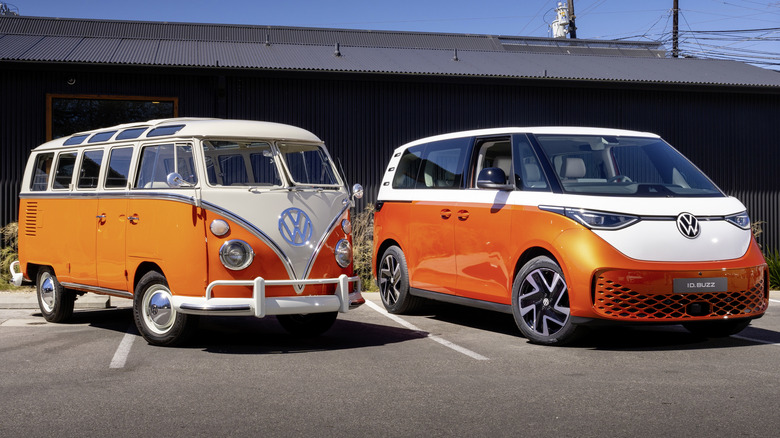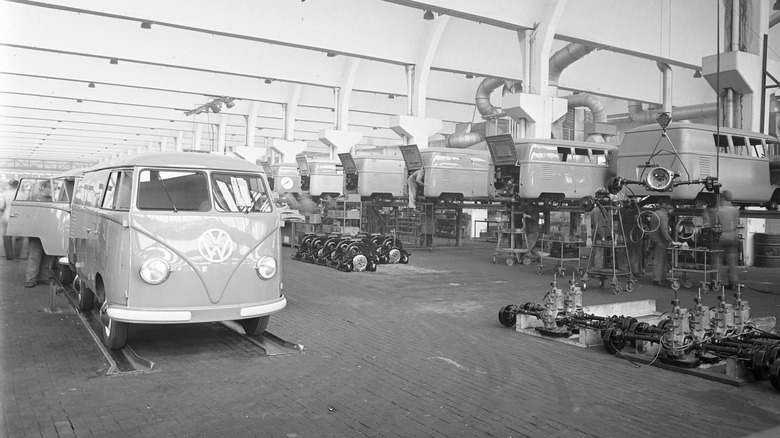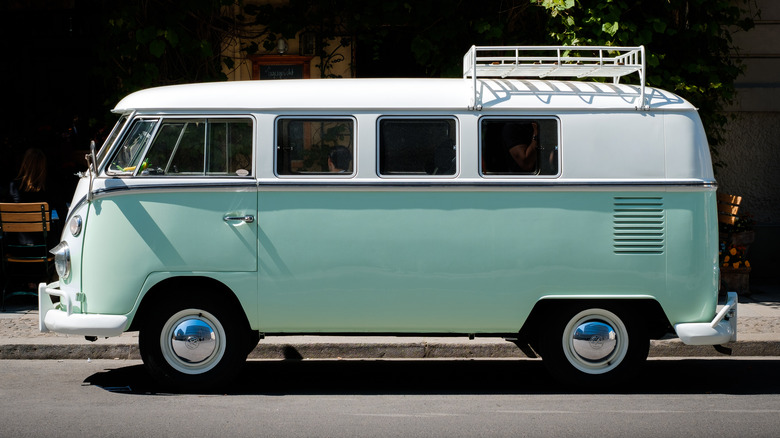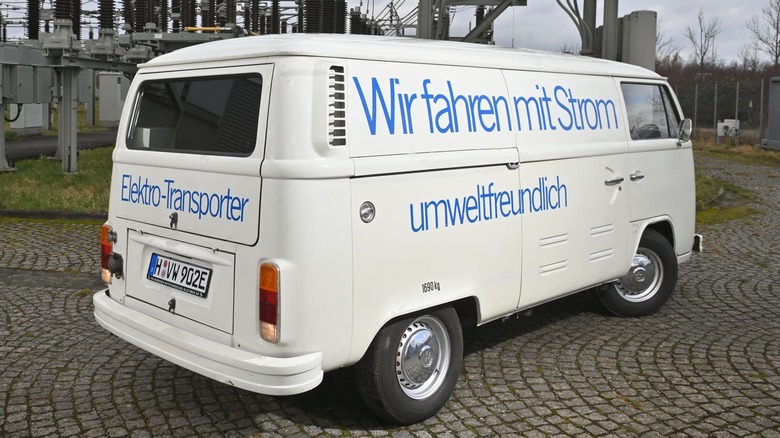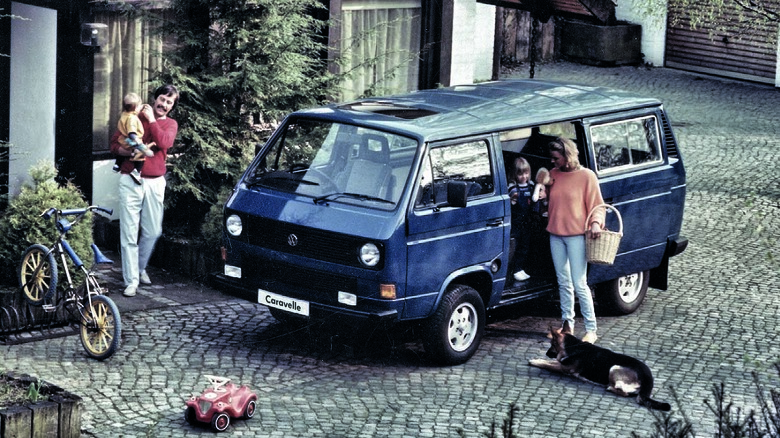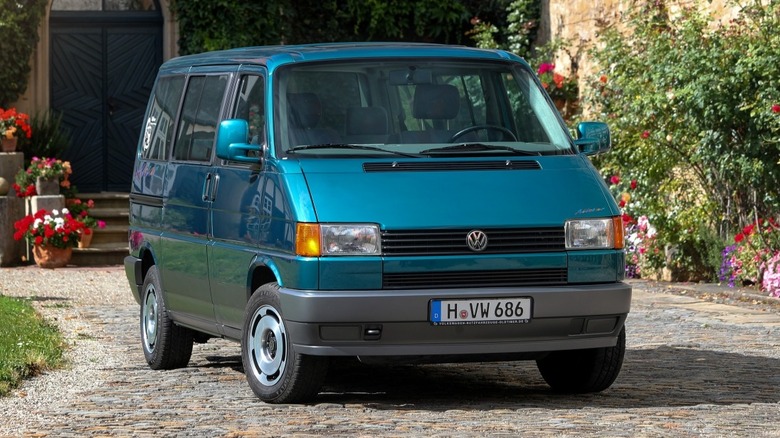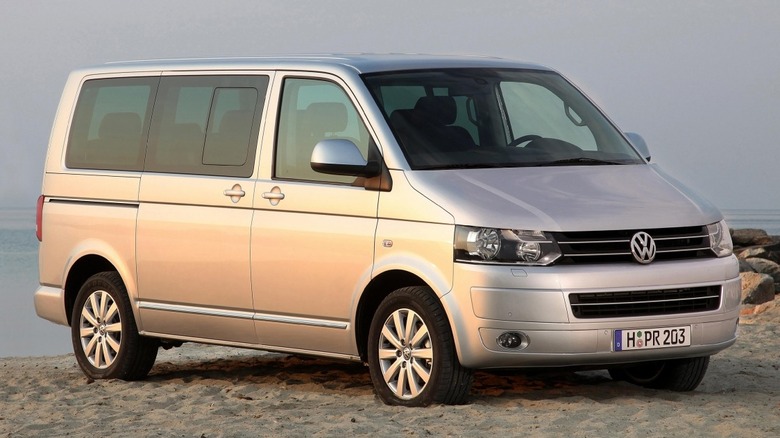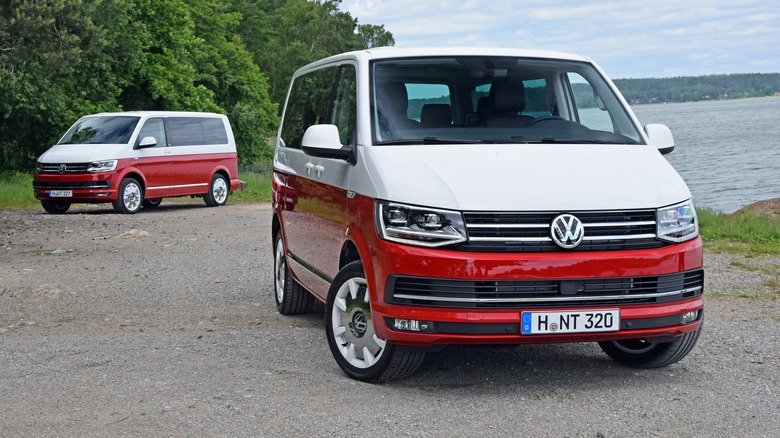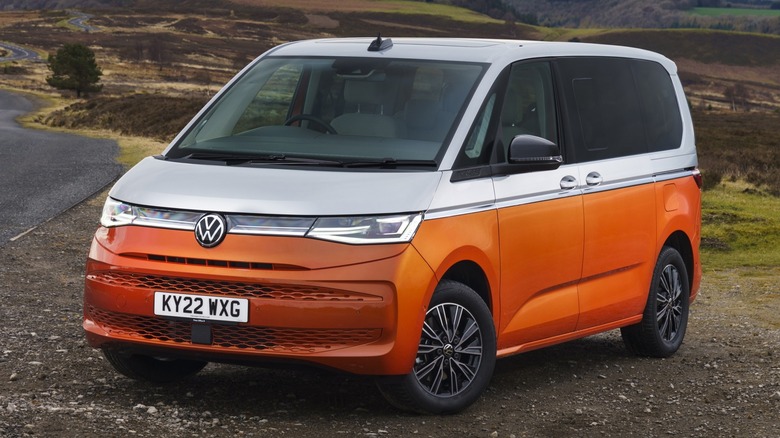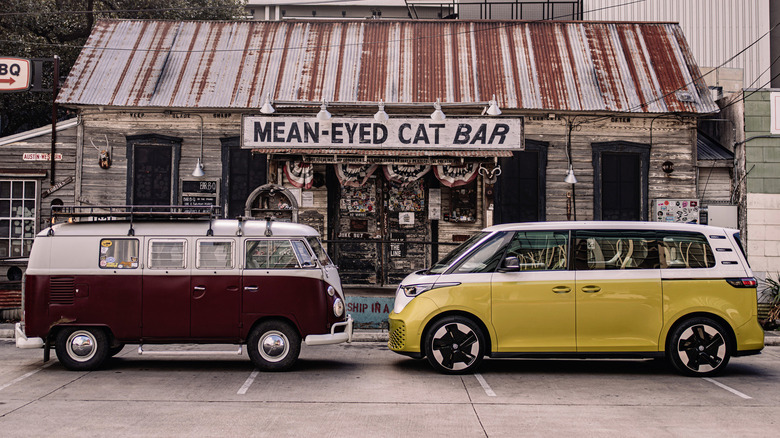VW Bus To ID.Buzz: A History Of Volkswagen Van Evolution
The VW Bus, also known as the Type 2 or Transporter, is in a class of its own in the van world. It has been in constant production since the 1950s and marketed in almost every major auto market. Over 9.2 million examples have been produced in its flagship factory in Germany, with millions more produced on regional production lines around the globe. Over eight generations and countless variations, the VW Bus has served as a home on wheels, a workhorse cargo van, and a symbol of counterculture.
Its affordable price, spacious interior, and iconic design make it instantly recognizable, and over the decades, it's become a sought-after collector's item too. Its popularity in so many territories around the world has meant that its production history is complex, with multiple generations often being built simultaneously for different markets.
The same is true today, with recently refreshed combustion variants of the legendary van being built side by side with its all-new, radical EV counterpart, the ID.Buzz. It remains to be seen how the changing automotive landscape will shape the future of the Bus, but here's a roundup of the iconic model's history so far.
Type 2 origins
VW's first model, the Type 1 (or Beetle/Bug), was designed at the behest of Nazi leadership during the 1930s. Intended to be the "people's car," its practical design had proven popular, but it wasn't enough to sustain VW after the war. So, based on the same underlying design, a new Type 2 design was created. It was to be a van — cheap, simple, and affordable — and the first production example rolled off the line in 1950.
VW wasn't the first manufacturer to create a compact, mass-produced cargo van. The Citroën Type H, with its distinctive corrugated body panels, had already been in production for three years by the time the VW Type 2 launched. However, it was the VW that was the first internationally successful van, being exported all over Europe and later to America. It was in these export markets where the Type 2's cult status would really be fostered, especially in the U.S., where it gained traction among a younger generation looking to drive something very different from their parents.
T1: The original Type 2
The original Type 2's affordability and interior space made it an ideal way to transport both people and cargo, but it soon became a fashion statement as much as it was a vehicle. It was picked up by the emerging hippie movement, who actively wanted to distance themselves from the increasingly large and powerful vehicles that most Americans were driving at the time. Even today, the idea of hippies driving flamboyantly decorated buses is still inseparable to many people's image of the van itself.
However, the Type 2 also played another important role in helping disadvantaged groups across America, in particular African Americans. In recent years, more efforts have been made to showcase this history, with Hagerty's National Historic Vehicle Register helping to rescue and preserve a VW bus owned by civil rights activists Esau and Janie B. Jenkins. After setting up a shuttle service to serve mostly Black residents around Charleston County, SC, the couple decided to use the time residents spent on the bus to teach them literacy skills and educate them about the constitution. Mr. and Mrs. Jenkins later went on to found the Progressive Club, a credit union, and a scholarship fund to help their community, playing a key role in the Civil Rights Movement. All the while, their Type 2 continued to serve as both a shuttle bus and a vitally important classroom.
T2: The survivor
From 1967 onwards, a new generation of the Type 2 was launched, referred to as the T2 (short for Transporter 2). The biggest visual change was the removal of the split windshield that had become a well-loved element of the original Type 2's design. In its place was a conventional, single-pane windshield. However, the key mechanical elements remained mostly unchanged. The van was still powered by a rear-mounted, air-cooled engine, still famously slow but cheap and easy to work on if anything went wrong.
It was also around this time that VW began work on a more radical design, one that would end up foreshadowing the future path of the model. In the early 1970s, concerns about fuel scarcity led VW to create a prototype "Elektro-Transporter," pictured above, with primitive lead-acid batteries and a range of just 25 miles. Following initial testing, a small run of 120 examples was produced, although the van's impractical range, coupled with its mere 43 mph top speed, meant it wasn't considered for wider production.
The T2 design proved to be consistently popular in developing economies around South America, to the point where VW continued local production for decades after other markets discontinued the van. In fact, the last T2, still with its classic looks and unchanged design, rolled out of the factory in 2013. Few vehicles can claim to have survived in production for so long without major design changes, but unfortunately new safety regulations in Brazil sealed the T2's fate.
T3: The last of its kind
The third generation of the Type 2 was introduced for the 1980 model year, sold under a variety of names by this point. In America, it was marketed as the Vanagon, and featured a number of improvements over its aging predecessor. It was less sluggish to drive, featured better build quality, and made even more effective use of its interior space. Unlike most other rival vans, the T3 still featured a rear-mounted engine, which enabled its unique, upright shape to remain mostly unchanged.
While it lacked the "flower power" appeal of earlier generations, the T3 was by most accounts a better van overall, even if it was becoming less competitive in the wider American market. Partly, this was due to the lasting effects of the Chicken Tax, which imposed a 25% tariff on imported vans and had been stifling demand for the Type 2 since the mid-'60s. It still offered plenty of charms, though, not least because it was still available with the popular Westfalia camper conversion that turned the van into a pint-sized mobile home. It still boasts a strong fanbase around the world too, with its appeal emphasized by the fact that the T3 is the last of its kind. The following generation would bring a host of changes that made it more competitive with its rivals, but lost many of the fundamental quirks that made the original Type 2 so appealing.
T4: Type 2 becomes the Transporter
Unveiled in 1990, the T4 was a very different vehicle to the VW buses of old. A major redesign saw the engine moved to the front of the van, necessitating a change from rear-wheel drive to front-wheel drive. In turn, that meant everything from the engine selection to the suspension had to be altered. It lost its official designation too, with the Type 2 name being dropped. The T4 was instead officially referred to as the Transporter in Europe and the Eurovan in America. Stateside sales began in 1992, but the fourth generation never proved as popular with American buyers.
Perhaps it was the design change, or perhaps it was simply changing market tastes that caused the decline in sales. Either way, the van was pulled from sale in the U.S. after the T4 generation was retired in 2003, although it would continue to remain on sale in various other markets around the world.
T5: Increased versatility
Sold between 2003 and 2015, the T5 built on the versatility offered by the T4 platform, offering more efficient engines and updated styling without changing the core formula that underpinned the previous generation. Like before, it was available in a variety of layouts, including as a panel van, a seven-seater minivan, and as a kitted-out campervan. The camper variant, sold as the California, proved especially popular, with over 50,000 examples sold over the course of production. In contrast, the first-generation California, the T3 generation, sold just 22,000 units.
The T5 followed a familiar pricing system too: It cost more to buy than many rival vans, but boasted consistently high build quality and, as a result, higher resale values than its competitors. Unlike older VW vans, however, the T5 was no slouch when it came to performance. The most powerful engine offered 180 horsepower, combined with optional all-wheel drive and a twin-clutch semi-automatic transmission. That made the T5 surprisingly brisk compared to previous iterations, even if it was still far from what most people would consider fast.
T6/T6.1: Improving the formula
The T6 debuted in 2015 with further refinements to the formula, including updated technology and improved safety features. In certain markets, it could be optioned with either a gasoline or a diesel four-cylinder engine, although some markets only sold the latter. Much like the T5 and T4 before it, front-wheel drive was standard, although all-wheel drive was available on certain variants. The T6 also kept previous iterations' premium price point, with well-optioned new examples of the camper variant stretching into the equivalent of six figures in U.S. dollars.
Despite the high cost, however, the T6 proved popular in its core European market, both as a workhorse cargo van and for hauling people and their belongings. The T6 was retired in 2022, although an updated version of the van, sold as the T6.1, continues to be produced and sold as both a commercial vehicle and as a camper.
T7: Rise of the Multivan
While it's the ID.Buzz that's stolen most of the headlines, VW's other new van is also a notable addition to the line. Known as the T7 Multivan, it's one of three separate successors to the T6, alongside the retro-modern ID.Buzz EV and a planned future commercial van built in partnership with Ford. So far, it's only the electric van that's been confirmed as launching stateside — Americans are missing out on the T7 for now.
The Multivan is more of the same from VW, but in a good way. Early reviews have reported that it's easy to drive, comfortable, and just as spacious inside as previous generations, especially in long-wheelbase form. It's also just as expensive: It starts at the equivalent of roughly $76,000 in the UK. It's available with gasoline, diesel, and plug-in hybrid powertrains, with the hybrid producing a combined 201 horsepower. It was first announced in 2022, and is being built alongside the ID.Buzz at VW's flagship plant in Hannover, Germany, the same place where the first Type 2 rolled off the production line more than 70 years ago.
ID.Buzz: an electric future
Although it's not slated to arrive in the U.S. until 2025, the ID.Buzz is already available in Europe and generating plenty of interest. So much so, in fact, that in early 2023 it was reported that the waitlist for the van stretched as long as 18 months for certain variants. There are set to be a few key differences between European and American versions: For example, the Euro-spec ID.Buzz is available in two-row form, but the American market version will only be available with three rows.
The American van also boasts a larger battery than the Euro van, with the goal of achieving a longer range. VW expects the U.S. van to be able to travel at least 250 miles between charges, although for now, there are no exact figures. The American van's top speed will be higher too, being capped at 99 mph, and it will be slightly more powerful, with 330 horsepower on tap.
The brand's other EVs, including the ID.4 SUV, have struggled to make an impact in America amid the increasing number of more memorable rivals on offer. Clearly, the ID.Buzz's distinctive retro-modern looks mean it'll have no trouble leaving a memorable first impression, but the future success of the Type 2 line depends on much more than just nostalgia. For now, it remains to be seen whether buyers will embrace the Buzz as much as they embraced the original bus.
